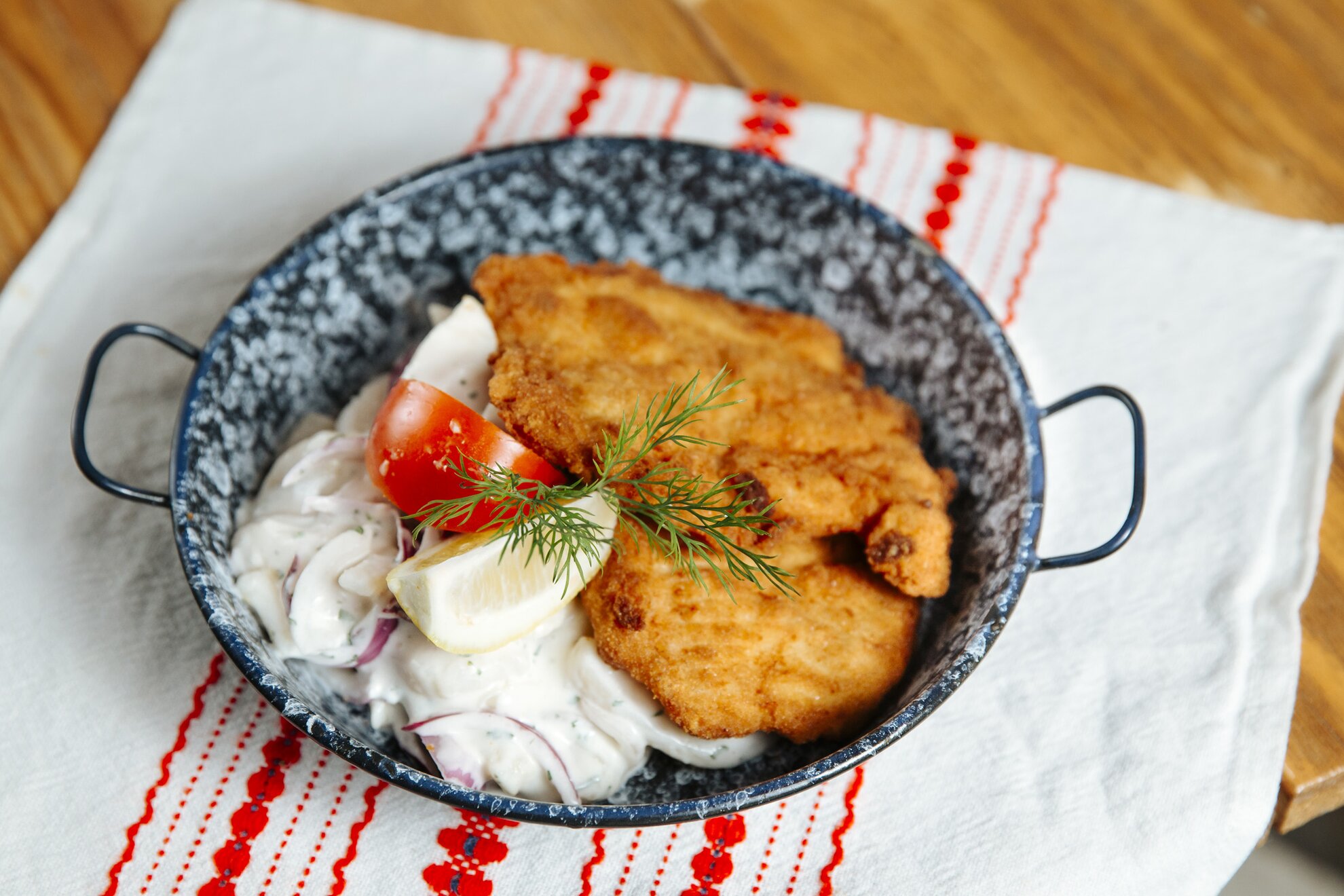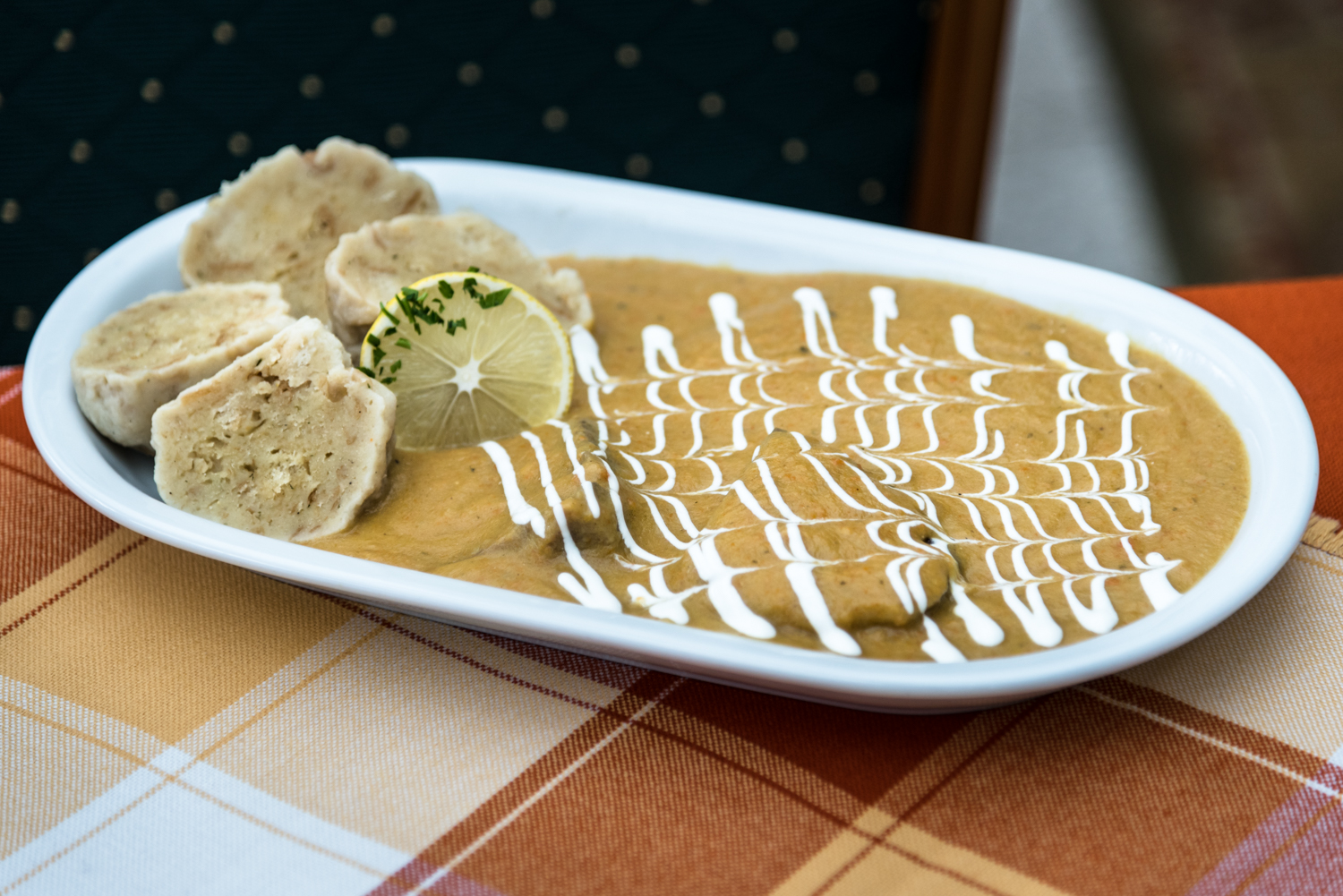Spicy, meaty, creamy, delicious – many words accurately describe Hungarian food, but “light” is not one of them. Quite a few classics of Hungary’s cuisine are unabashed calorie bombs, from street-food specialties to savory main dishes to decadent desserts, and while health-conscious Budapest visitors may try to defy the overwhelming temptation to feast on these local treats, resistance is usually futile. Warning: just one look at any of the following delicacies will induce cravings that can only be cured by pigging out on them at varied eateries around Budapest.
STREET FOOD
Lángos (deep-fried dough)

Almost every Hungarian market hall, festival, and holiday destination has at least one constantly crowded lángos stand, where a few hundred forints buys a freshly fried disk of dough (ideally crispy on the outside and soft within) typically topped with garlic butter, sour cream, and shredded cheese, although other additions are often available. There’s not a whole lot of nutritional value in this longtime local street food, but it’s definitely a satisfyingly filling delight for any sunshiny afternoon outing or drunken late-night munching session – especially if you order your lángos stuffed with sausage and/or bacon.
Where to try it in Budapest:Great Market Hall, Retró Lángos
Kürtőskalács (chimney cake)

This is the lightest treat on this list, but considering that Hungary’s unique cylindrical pastry is basically sugary baked dough coated with cinnamon, cocoa powder, and other sweet toppings, kürtőskalács is still a far cry from a healthy snack. The enticing aroma of chimney cakes cooking on wooden spits over hot coals is an especially tempting element of Budapest’s Christmas-season fairs, but it’s also a fun food to eat on the go when purchased at random booths citywide. After a recent kürtőskalács revolution, specialty shops now sell new-wave chimney cakes loaded with goodies ranging from ice cream to meatballs.
Where to try it in Budapest:Hoppácska, Molnár’s Kürtőskalács, Street Cakes
SAVORY DISHES
Szalonna (smoked pork fat)

It’s often called “bacon”, but szalonna is very different from the American breakfast staple – we’re talking thick strips of white fatback with the rind attached, prominently displayed in butcher counters across Hungary. The traditional way to eat szalonna is cooking it over a summertime bonfire on a skewer along with a sausage and an onion; when the heated fat starts dripping, you catch that artery-clogging goodness on a piece of bread before eating all of the above. However, this beloved lard is also found in some Hungarian dishes, like Cigánypecsenye (pictured above) – a roasted pork flank topped with juicy szalonna.
Where to try it in Budapest:Pesti Vendéglő, Rákóczi Restaurant
Rantott hús (fried meat)

A culinary cousin of neighboring Austria’s schnitzel, rantott hús is the star at family lunches convened every Sunday all over Hungary. Veal and pork are the preferred meats that are coated in breadcrumbs and cooked in sizzling oil to create this scrumptiously high-calorie specialty, although rantott hús is also made from chicken, turkey, or pretty much any dead animal of substantial size. Rantott hús is widely available at Budapest restaurants, including local fast-food outlets serving deep-fried chicken fillets on sandwiches topped with cheese, mayonnaise, and other corpulence-inducing ingredients.
Where to try it in Budapest:Belvárosi Disznótoros, Csirke Csibész, Pest-Buda
Libamáj (goose foie gras)

This delicacy is controversial (for animal-welfare reasons, not because of its high calorie content), but goose liver remains an epicurean highlight of Magyar cuisine – after France, Hungary is the world’s second-biggest foie-gras producer. If you don’t mind the force-feeding practices inherent to foie gras, Budapest is an excellent place to indulge in it – Hungarian chefs typically sauté libamáj in goose fat and serve it as a gourmet extravagance, while cans of creamy foie gras pâté are a popular souvenir brought home by Hungary visitors… but with over 40% fat content, this is not a nice gift for weight-watching friends.
Where to try it in Budapest:Bock Bistro, Firkasz, Macesz Bistro
Vadas marha (hunter-style beef)

Comfort food doesn’t get much more comfortable than vadas marha. Take slices of roasted beef, drown them in a rich citrus-tinged sauce made with sour cream, caramelized sugar, lard, and other guilty pleasures, and serve with oversized bread dumplings dipped in a butter-based batter (and optionally enhanced with grated smoked cheese) – and presto, you have this Magyar feast sure to make any hunter feel inclined to take a long nap after eating it and forget all about going back into the woods to find the next day’s meal. There may be heavier specialties in the classic Hungarian cookbook, but our cardiologist won’t let us look for them.
Where to try it in Budapest:Fenyőgyönge Vendéglő, Pozsonyi Kisvendéglő
DECADENT DESSERTS
Túrógombóc (cottage-cheese dumplings)

For anyone with a sweet tooth, túrógombóc could certainly suffice as a meal, especially since it’s usually served in a portion size about as big as a main course. Hungary’s answer to cheesecake is based on large breadcrumb-coated dumplings formed from the country’s ubiquitous túró cheese – made with curds, similar to quark or cottage cheese – which isn’t actually all that fattening in and of itself... but after the dumplings are boiled, they’re slathered with sour cream (or sometimes a thick vanilla sauce) and topped with plenty of powdered sugar, making this a worthy addition to this list of tempting treats.
Where to try it in Budapest:Déryné Bistro, Otthonka
Madártej (floating island)

This liquid dessert’s name means “bird’s milk”, and as fanciful as that title may seem, it’s even more implausible to have a spoonful of it without wanting to devour the entire bowlful in a few gluttonous gulps. Basically custard topped with a meringue ball, madártej is similar to the French floating island, but the Hungarian version of it is made with whole milk and less sugar than the Gallic variety (surprisingly enough). Eggs, sugar, milk, and vanilla are all it takes to make this dish – oh, and lots of time, since the meringue balls must be made a day in advance… but eating madártej usually takes no time at all.
Where to try it in Budapest:ÉS Bisztró, Vakvarjú
Palacsinta (filled thin pancakes)

In Hungary, palacsinta crepe-style pancakes are perennially popular in places ranging from grandma’s kitchen to cheap lunch halls to gourmet restaurants. These doughy delights are cooked thin and rolled up with myriad sweet and savory fillings such as cocoa powder, shredded cheese, and ice cream. Perhaps the most famous variety is the legendary Gundel palacsinta, affiliated with the historic restaurant in Budapest’s City Park of the same name; this belt-busting delicacy is filled with rum-walnut sauce and raisins, fried in butter, slathered with chocolate sauce, and topped with whipped cream.
Where to try it in Budapest:Gundel Restaurant, Náncsi Néni Vendéglője
Classic Hungarian cakes

Slices of unique Hungariancakes are a primary ingredient of Budapest’s historic coffeehouse culture, and each of these traditional confections have their own irresistible character. Among the many varieties, the most famous are Dobos torte (sponge cake with chocolate buttercream and a hard caramel topping, named after Hungarian confectioner József Dobos), Eszterházy torta (layers of walnut-flavored meringue with vanilla buttercream and chocolate stripes), and Somlói galuska (balls of sponge cake drizzled with rum sauce and chocolate and topped with whipped cream) – needless to say, any of these can wreck a diet instantly.
Where to try it in Budapest:Centrál Café, Daubner Confectionery, Gerbeaud Confectionary




